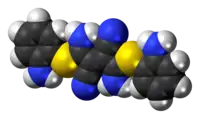U0126
U0126[1][2] is the 'code' name for a compound associated with cancer treatment[3] and also in preventing ischemia and cellular oxidative stress. It also has likely utility in strokes and heart attacks.[4] This compound is available for research purposes from a number of companies.[5][6]
 | |
 | |
| Identifiers | |
|---|---|
| |
| CAS Number | |
| PubChem CID | |
| ChemSpider | |
| UNII | |
| ChEBI | |
| ChEMBL | |
| Chemical and physical data | |
| Formula | C18H16N6S2 |
| Molar mass | 380.49 g·mol−1 |
| 3D model (JSmol) | |
| |
| |
| | |
The specific compound is not approved by the FDA as a therapeutic agent, though it has been used in medical settings.[7] Members of this broad class of chemical compounds have been approved by the US FDA for the treatment of specific cancers.[8][9]
It is a highly selective inhibitor of both MEK1 and MEK2, a type of MAPK/ERK kinase.[10][11] U0126 was found to functionally antagonize AP-1 transcriptional activity via noncompetitive inhibition of the dual specificity kinase MEK with IC50 of 72 nM for MEK1 and 58 nM for MEK2. U0126 inhibited anchorage-independent growth of Ki-ras-transformed rat fibroblasts by simultaneously blocking both extracellular signal-regulated kinase (ERK) and mammalian target of rapamycin (mTOR)-p70(S6K) pathways.[12]
The effects of U0126 on the growth of eight human breast cancer cell lines shown that U0126 selectively repressed anchorage-independent growth of MDA-MB231 and HBC4 cells, two lines with constitutively activated ERK.[13] Loss of contact with substratum triggers apoptosis in many normal cell types, a phenomenon termed anoikis. U0126 sensitized MDA-MB231 and HBC4 to anoikis, i.e., upon treatment with U0126, cells deprived of anchorage entered apoptosis.
U0126 is also a weak inhibitor of PKC, Raf, ERK, JNK, MEKK, MKK-3, MKK-4/SEK, MKK-6, Cdk2 and Cdk4.
Its potential for wiping long-term memories in rats has been studied at the Center for Neural Science at New York University.[14]
See also
References
- Ong, Qunxiang; Guo, Shunling; Zhang, Kai; Cui, Bianxiao (2014-12-27). "U0126 Protects Cells against Oxidative Stress Independent of Its Function as a MEK Inhibitor". ACS Chemical Neuroscience. 6 (1): 130–137. doi:10.1021/cn500288n. ISSN 1948-7193. PMC 4304487. PMID 25544156.
- "U-0126". go.drugbank.com. Retrieved 2023-10-23.
- You, Yijie; Niu, Yunlian; Zhang, Jian; Huang, Sheng; Ding, Peiyuan; Sun, Fengbing; Wang, Xuhui (2022-08-25). "U0126: Not only a MAPK kinase inhibitor". Frontiers in Pharmacology. 13: 927083. doi:10.3389/fphar.2022.927083. ISSN 1663-9812. PMC 9452634. PMID 36091807.
- Namura, Shobu; Iihara, Koji; Takami, Shinya; Nagata, Izumi; Kikuchi, Haruhiko; Matsushita, Koji; Moskowitz, Michael A.; Bonventre, Joseph V.; Alessandrini, Alessandro (2001-09-25). "Intravenous administration of MEK inhibitor U0126 affords brain protection against forebrain ischemia and focal cerebral ischemia". Proceedings of the National Academy of Sciences of the United States of America. 98 (20): 11569–11574. Bibcode:2001PNAS...9811569N. doi:10.1073/pnas.181213498. ISSN 0027-8424. PMC 58770. PMID 11504919.
- "MEK Inhibitor U0126". www.promega.com. Retrieved 2023-10-24.
- "U0126". InvivoGen. 2016-11-25. Retrieved 2023-10-24.
- Cheng, Ying; Tian, Hongqi (October 2017). "Current Development Status of MEK Inhibitors". Molecules. 22 (10): 1551. doi:10.3390/molecules22101551. ISSN 1420-3049.
- Research, Center for Drug Evaluation and (2023-03-31). "FDA approves dabrafenib with trametinib for pediatric patients with low-grade glioma with a BRAF V600E mutation". FDA.
- "Trametinib". go.drugbank.com. Retrieved 2023-10-24.
- Favata MF, Horiuchi KY, Manos EJ, Daulerio AJ, Stradley DA, Feeser WS, et al. (July 1998). "Identification of a novel inhibitor of mitogen-activated protein kinase kinase". The Journal of Biological Chemistry. 273 (29): 18623–32. doi:10.1074/jbc.273.29.18623. PMID 9660836. S2CID 9896161.
- DeSilva DR, Jones EA, Favata MF, Jaffee BD, Magolda RL, Trzaskos JM, Scherle PA (May 1998). "Inhibition of mitogen-activated protein kinase kinase blocks T cell proliferation but does not induce or prevent anergy". Journal of Immunology. 160 (9): 4175–81. doi:10.4049/jimmunol.160.9.4175. PMID 9574517. S2CID 44967290.
- Duncia JV, Santella JB, Higley CA, Pitts WJ, Wityak J, Frietze WE, et al. (October 1998). "MEK inhibitors: the chemistry and biological activity of U0126, its analogs, and cyclization products". Bioorganic & Medicinal Chemistry Letters. 8 (20): 2839–44. doi:10.1016/s0960-894x(98)00522-8. PMID 9873633.
- Fukazawa H, Noguchi K, Murakami Y, Uehara Y (March 2002). "Mitogen-activated protein/extracellular signal-regulated kinase kinase (MEK) inhibitors restore anoikis sensitivity in human breast cancer cell lines with a constitutively activated extracellular-regulated kinase (ERK) pathway". Molecular Cancer Therapeutics. 1 (5): 303–9. PMID 12489846.
- Smith K (2007-03-11). "Wipe out a single memory". Nature Magazine. Retrieved 2017-12-31.